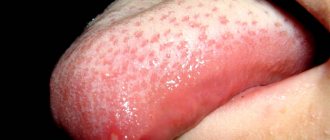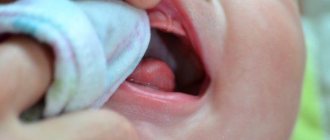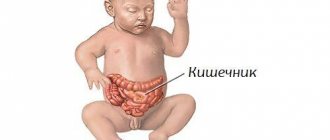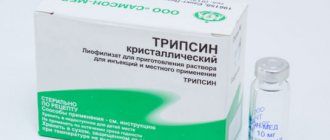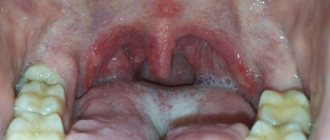From this article you will learn:
- how to treat aphthous stomatitis in children,
- symptoms and treatment of aphthous stomatitis in adults,
- list of effective drugs.
The article was written by a dentist with more than 19 years of experience.
Aphthous stomatitis is a disease in which one or more round ulcerations appear on the oral mucosa, which are covered with a necrotic coating of a gray or yellowish tint. Such ulcers (synonymous with aphthae) are not the result of acute infections, and therefore are not contagious, but nevertheless, such damage to the mucous membrane will require specific therapy.
According to statistics, up to 20% of the population suffers from this form of stomatitis. Young children, as well as adults aged 20 to 30 years, are especially susceptible to this disease. In people of more mature age, there is a dependence: the higher the age, the less likely it is to develop. Aphthous stomatitis has a code according to ICD 10 - K12.0. Below you can see what this disease looks like in children and adults.
Aphthous stomatitis in children: photo
Aphthous stomatitis: photos in adults
The most important thing in treating stomatitis is to first correctly determine its form. Indeed, depending on its form, and it can be either herpetic or aphthous stomatitis, treatment for both adults and children will be completely different. Therefore, if you are not very sure of the diagnosis, it is best to familiarize yourself with the symptoms of both forms before starting treatment.
Causes of stomatitis
Stomatitis is both an independent disease and a manifestation of other diseases. The causes of stomatitis can be:
| CAUSES | A COMMENT | ||
| causes: | Viruses: | a comment: | herpes simplex virus, varicella-zoster virus |
| causes: | Mushrooms: | a comment: | yeast-like fungi of the genus Candida. |
| causes: | Bacteria: | a comment: | fusobacteria, streptococci, gonococci, mycobacterium tuberculosis, mycobacterium leprosy. |
| causes: | Allergy: | a comment: | stomatitis can be a consequence of food, household and drug allergies. |
| causes: | Injuries | ||
| causes: | Hygiene: | a comment: | Poor oral hygiene, this includes both the presence of dental deposits (tartar and plaque), and the presence of many foci of infection (caries and its complications), old fillings and crowns. |
| causes: | A number of diseases: | a comment: | — diseases of the digestive system (Crohn’s disease2, gastroesophageal reflux disease3, gastritis4) — chronic heart failure5 — diabetes mellitus6 — vitamin C hypovitaminosis — chronic tonsillitis — insufficient pancreatic function |
Classification of stomatitis by the World Health Organization7
| CLASSIFICATION | A COMMENT | ||
| classification: | According to the degree of damage to the mucous membrane | a comment: | 1) Superficial (catarrhal, fibrinous) 2) Deep (ulcerative, necrotic) |
| classification: | Due to the occurrence: | a comment: | 1) infectious (viral, bacterial, fungal) 2) traumatic (mechanical, chemical or physical injury) 3) allergic 4) arising from systemic diseases |
| classification: | According to the clinical course: | a comment: | 1) acute 2) chronic |
Catarrhal stomatitis
Characterized by redness, slight swelling, burning of the mucous membrane. It is observed with influenza, acute respiratory viral infections, and drug-induced damage.
Fibrinous stomatitis
It manifests itself as single painful aphthae, which are covered with a white coating. Afta is a superficial defect of the oral mucosa of a round shape. It appears in mild forms of aphthous stomatitis.
Ulcerative stomatitis
manifests itself in the form of deep defects in the oral mucosa - ulcers. Observed in traumatic stomatitis.
Necrotizing stomatitis
Characterized by ulcers that are covered with necrotic plaque. It is observed in ulcerative-necrotizing gingivitis, a complication of measles.
Acute stomatitis
It has pronounced symptoms, as a rule, it appears for the first time or recurs extremely rarely, once every few years. Also occurs due to acute trauma. Patients complain of severe pain, difficulty eating and sometimes even talking, general weakness, fever, and bad breath. Acute stomatitis with incomplete or improper treatment can become chronic.
Chronic stomatitis
Characterized by constant relapses, as a rule, this occurs when the immune system is weakened. May occur as a result of regular, moderate trauma. Clinical manifestations are less pronounced; this type of stomatitis always requires first of all eliminating the cause of the disease.
Types of disease
According to ICD-10, aphthous stomatitis is assigned code K.12. Within the code there are three qualifying diagnoses, including K.12.0 - “recurrent aphthae of the oral cavity,” which also includes aphthous ulcers.
According to the form of occurrence, acute and chronic aphthous stomatitis are distinguished. The first is characterized by the appearance of ulcers and severe hyperemia - swelling, redness of the mucous membranes. Severe pain occurs, especially when eating or talking. Submandibular lymph nodes may enlarge and body temperature may rise.
Chronic recurrent aphthous stomatitis may be the result of improper or untimely treatment, as well as the inability of the immune system to cope with the disease. It is characterized by periodic exacerbations. Outside of exacerbation, symptoms may be erased or completely absent.
The disease is classified into three forms depending on the severity:
- light. From 1 to 2 afts up to 10 mm in size. Moderate pain during mechanical action, relapses occur no more than 2 times a year;
- average. Up to 5 aft, the course of treatment takes up to 3 weeks. The pain is quite pronounced, there is an enlargement of the lymph nodes, relapses up to 2 times a year;
- heavy. Multiple aphthae appear, severe pain. An increase in temperature occurs, and symptoms of general intoxication appear. Treatment takes up to a month, relapses occur up to 6 times a year.
Also, according to the form of occurrence, the following types of inflammatory diseases are distinguished:
- fibrous: blood microcirculation in the upper layer of the mucosa is disrupted, aphthae appear, covered with a fibrous film (plaque). Such ulcers heal completely within 14 days. The disease affects the mucous membrane of the lips, the lateral surfaces of the tongue, and transitional folds. This stomatitis recurs up to 3 times a year;
- necrotic. The epithelium is destroyed, the mucosal area dies. Replacement of tissues with normal epithelium takes from 14 to 30 days. This aphthous stomatitis is not accompanied by acute pain; it is usually observed in patients with severe diseases, including blood pathologies;
- grandular. Damage to the ducts of the minor salivary glands occurs. In this regard, aphthae form close to the glands, and drying of the mucous membranes of the oral cavity occurs due to a decrease in saliva production. Ulcerations are painful and heal within 1–3 weeks;
- scarring. Damage to the cavity of the salivary glands leads to the involvement of connective tissue in inflammation. Aphthae are observed both at the location of the glands and on the mucous membranes of the pharynx and palate. The disease develops into large painful ulcers (up to 1.5 cm). Healing takes up to 12 weeks; after the acute process, pronounced scars remain;
- deforming. The most severe form of the disease, which provokes changes in connective tissue. Aphthae heal extremely slowly, which is accompanied by deformation of the palate, lips, and sometimes narrowing of the oral cavity occurs (if aphthae was observed in the corners of the mouth).
Ask a Question
Viral stomatitis
Herpetic stomatitis
Caused by the herpes virus of the first, less often the second type.
It accounts for 80% of all stomatitis and occurs mainly in children, less often in adults. The prevalence of herpes simplex virus ranges from 65% to 90%8. Infection occurs through airborne droplets and household contact. More common is recurrent herpetic stomatitis, which is manifested by itching, burning, slight soreness in the oral cavity, then vesicles (bubbles) appear, which burst and heal after 7-10 days.
During primary infection, acute herpetic stomatitis occurs; it is characterized by general symptoms such as fever, weakness, aches in the muscles and joints, the degree of these manifestations depends on the severity of the disease. As a rule, the acute form occurs in children.
Varicella zoster virus infection
The mildest form, in which the mucous membrane of the tonsils is affected. The palatine tonsils are not very enlarged, the mucous membrane of the throat is red, there is no plaque or pus.
Stomatitis with measles
Measles is an acute viral, highly contagious disease that is caused by the Polinisa virus and is transmitted by airborne droplets. The disease is extremely contagious. It is characterized by a rise in temperature, symptoms of ARVI, a rash on the face, neck, and then the whole body. In the oral cavity, Filatov-Koplik spots and stomatitis occur, which is characterized by hyperemia, swelling of the mucous membrane and white plaque. Nowadays, thanks to vaccination, this disease practically does not occur.
Aphthous stomatitis: treatment, drugs
Aphthous stomatitis in adults is the same as canker sores in children - the treatment is the same, and the treatment strategy described below is suitable for patients of any age. As for the medications listed later in the article, some of them do have age restrictions, which we will also indicate.
Due to the fact that it is usually impossible to clearly identify the specific cause of aphthous stomatitis in a particular patient, treatment will be multifocal, i.e. drugs of several groups are used simultaneously. The choice of treatment strategy and medications will depend on the following 3 factors:
1) on the severity of symptoms, 2) on the frequency of relapses, 3) on identified predisposing factors.
Treatment at the first stage should be aimed at reducing pain and inflammation in the area of ulcers, and at the second and third stages - at speedy epithelization of ulcers and preventing their occurrence in the future. To facilitate the choice of the best treatment option, all patients can be divided into 3 types (according to the criteria - severity of the disease and frequency of relapses).
- Type A - in patients of this type, aphthous stomatitis occurs no more than several times during the year and is characterized by slight pain.
First of all, in such patients it is necessary to identify local predisposing factors and eliminate them (for example, overhanging edges of fillings or hygiene products with sodium lauryl sulfate). It is important to ask the patient about eating habits to evaluate a possible relationship between stomatitis outbreaks and certain foods. The patient is advised to avoid solid foods (eg, crackers, toast), all types of nuts, chocolate, eggs, acidic drinks or foods - fruit or citrus juices, tomatoes, pineapples, salty foods. You should avoid eating spicy foods, any spices, including pepper and curry, as well as alcoholic and carbonated drinks. In type A patients, local symptomatic therapy is mainly used, which includes antiseptic rinses and gel applications for pain and inflammation + antihistamines.
- Type B - in such patients, aphthous stomatitis develops almost monthly, and the ulcers are so painful that they force the patient to change habits (for example, brushing teeth less often due to severe pain). It remains important to identify local and general predisposing factors and, if possible, eliminate them. It is very important to teach patients of this type to feel the first signs of the imminent appearance of ulcers - burning, itching or swelling of the mucous membrane, in order to provide early local treatment even before the formation of the ulcers themselves.
- Type C - in patients of this type, ulcers are very painful, appear so often that while one lesion is healing, the next one appears almost immediately. This group also includes patients in whom local treatment in the oral cavity is completely ineffective, and improvement in their condition occurs only after the use of systemic therapy (we will also discuss such therapy below).
Stomatitis caused by fungi
Candidal stomatitis is a fungal disease caused by fungi of the genus Candida.10 Young children and the elderly are more often affected; people with diabetes and xerostomia (dry mouth), pregnant women and people with weakened immune systems are also at risk. Elderly people wearing removable dentures often get sick.
The main symptom of fungal stomatitis is a burning sensation and the presence of a white, cheesy coating, when removed, a swollen, red mucous membrane appears. The general condition of adults with candidal stomatitis is practically not affected.
Features of treatment in children
The dentist will tell you how to treat aphthous stomatitis in a child. You can contact him at the direction of your pediatrician or on your own if you find characteristic ulcers in the oral cavity. The treatment regimen is the same as that used in the treatment of adult patients, but there are some differences: children under a certain age cannot rinse the mouth, so preference is given to drugs for application to mucosal ulcers. Otherwise, the treatment regimen is developed individually, taking into account the severity, symptoms of the disease, frequency of relapses, and the presence or absence of concomitant ailments in the child. Symptomatic therapy can be used to quickly alleviate the baby’s condition.
Specialists at STOMA clinics successfully treat aphthous stomatitis. By contacting us, you will receive qualified assistance, detailed recommendations on the treatment and prevention of relapse of the disease, and comprehensive assistance from dentists of all specializations, if necessary.
Bacterial stomatitis
Vincent's ulcerative necrotizing stomatitis
It manifests itself as ulcerations of the mucous membrane, strong odor from the mouth, fever, weakness, pain when eating. In severe forms, ulcerations can occupy almost the entire oral cavity, and the temperature rises above 38°C.
Gonorrheal stomatitis
Caused by Neisser's gonococcus. The mucous membranes of the lips, gums, lateral and lower surfaces of the tongue are mainly affected. The mucous membrane has a brightly hyperemic color and a large amount of gray purulent plaque with an unpleasant odor. But, as a rule, there are no complaints.
Acute streptococcal gingivostomatitis
It is characterized by general damage to the gums, severe pain, fever, enlargement and tenderness of the lymph nodes. The mucous membrane of the mouth and tonsils is hyperemic, abscesses may form.
Diagnostic features
At the initial appointment, the dentist examines the oral cavity and analyzes complaints. To make an accurate diagnosis, you need to distinguish this form of the disease from others, as well as differentiate it from other pathologies that have similar symptoms. For extensive lesions, different diagnostic methods may be used:
- clinical blood tests;
- microflora smear;
- blood for PCR to determine the causative agent of the disease;
- biopsy (if indicated).
They are also necessary for recurrent forms of the disease. In simple cases, laboratory diagnostics are not required; aphthae are determined visually by an experienced specialist.
With the help of a comprehensive examination, the doctor will determine which microorganism caused inflammation with subsequent ulceration of the mucous membrane. He also differentiates the disease from herpetic stomatitis and oncological pathology.
Traumatic stomatitis
Traumatic stomatitis develops as a result of mechanical, thermal or physical trauma. This type of stomatitis occurs:
- superficial (burn of the mucous membrane by hot tea)
- deep (burn with a strong alkali or acid, strong biting of the mucous membrane)
Acute mechanical stomatitis: rare, it can be caused by trauma to the mucous membrane when biting the cheek, tongue, lip while eating, an attack of epilepsy, a blow, trauma during dental treatment and other traumatic factors.
It is manifested by pain, hyperemia, swelling at the site of injury, erosion. With secondary infection, the wound can develop into long-term non-healing ulcers. Most often, traumatic stomatitis is acute, but can also be chronic, for example, constant biting of the cheeks under stress, chronic injury from braces, a sharp tooth edge, or a bad crown. As a result of trauma, painful erosions or ulcers with jagged edges form on the mucous membrane, which can become infected.
The cause of physical injury is most often a thermal burn due to contact with hot liquid, inhalation of steam, or exposure to fire, the latter, as a rule, accompanied by damage to the respiratory tract. The lesion is most often located on the tip of the tongue, lips, and the front of the palate. The mucous membrane becomes swollen, red, painful, and blisters may form, which then burst. With deep damage, the mucous membrane dies, and the damage involves muscles and even bone.
Chemical stomatitis occurs when burned with acid or alkali. In everyday life, this is most often acetic acid; also at a dental appointment, burns can occur with various drugs (phenol, formaldehyde, alcohol, hydrofluoric acid, etc.). The depth of damage depends on the damaging substance and its concentration, and the duration of exposure. First, the mucous membrane becomes bright red and painful, and with severe lesions, foci of necrosis then appear within a few hours.
In case of burns with acids, alkalis, or thermal burns, it is recommended to call an ambulance!
Allergic stomatitis
They arise as a reaction of the mucous membrane to an allergen. An allergic agent can be toothpastes, mouthwashes, food, medicines, materials for crowns, fillings, etc. Allergies often occur to removable dentures. The mucous membrane is affected precisely at the point of contact with the damaging agent, for example, the hard palate under a removable denture. With allergic stomatitis, the mucous membrane is swollen, red, bubbles appear, which burst with the appearance of painful erosions.
Allergic stomatitis also includes chronic recurrent aphthous stomatitis , it begins with swelling and burning, then a painful aphtha appears, and then a healing period begins. This disease is characterized by constant relapses with a certain frequency.
Additional recommendations –
As soon as you notice the appearance of ulcers due to aphthous stomatitis, immediately start taking an antihistamine (anti-allergy) drug, plus eliminate from your diet all the foods and drinks that we described above. Immediately begin local therapy, which includes antiseptic rinses, anti-inflammatory gel + bismuth-based product to protect the surface of the ulcers from irritants. See if your toothpaste contains sodium lauryl sulfate or parabens, and if so, it is worth purchasing a toothpaste without these ingredients.
If brushing your teeth causes pain, then buy a soft toothbrush (they are usually used for inflammation and bleeding gums). For adults and children with constantly recurring outbreaks of aphthous stomatitis, there is an excellent preventive remedy - toothpastes with licorice extract and a whole complex of lactic enzymes. These components increase the protective factors of the oral mucosa, preventing the development of new cases of aphthous stomatitis.
Additional laboratory tests - with frequent, recurring outbreaks, a complete blood count should be performed to rule out hematological diseases. It is important to check blood plasma immunoglobulins and the number of lymphocytes, and take a test for HIV infection. To exclude autoimmune diseases, the patient is usually referred for the following tests:
- erythrocyte sedimentation rate,
- antinuclear antibodies and antineutrophil cytoplasmic antibodies,
- IgA-antiendomysial antibodies,
- antibodies to tissue transglutaminase.
If ulcerative lesions heal very poorly, take a long time and practically do not respond to local treatment, it is necessary to refer the patient for a biopsy to exclude granulomatous conditions such as orofacial granulomatosis, tuberculosis or malignant tumors.
Calling a doctor to your home –
If your child has stomatitis, it is very important to correctly determine its shape. Usually this is either an aphthous or herpetic form of stomatitis, and the most important thing is that they are treated completely differently. If your child develops stomatitis, you should not call the pediatrician. These specialists usually do not even know that there are several forms of stomatitis, and many of them still recommend treating them with brown, blue or Metrogil-dent gel. Or they prescribe a whole bunch of drugs with opposite effects - as if “at once for everything.”
It makes sense to contact a pediatrician only if the child’s general condition is severe, i.e. symptoms of intoxication (high temperature, dehydration...), but such symptoms are characteristic not of aphthous stomatitis, but of primary acute herpetic stomatitis. Therefore, it is optimal to contact a pediatric dentist, and you can always arrange a house call at the reception of a pediatric dental clinic. We hope that our review “Aphthous stomatitis: treatment in adults and children” was useful to you!
Sources:
1. Dental education of the author of the article, 2. National Library of Medicine (USA), 3. Textbook “Pediatric Dentistry” (Kolesov A.A.).4. “Pediatric therapeutic dentistry. National leadership" (Leontyev V.K.). 5. “Clinical recommendations (treatment protocol) for chronic recurrent aphthous stomatitis” (Volkov E.A., Butova V.G.).
Prevention of stomatitis
Consists of the following items:
- strengthening the immune system, giving up bad habits, hardening, playing sports, eating with a sufficient amount of macros and vitamins (especially vitamin C)
- regular visits to the dentist
- adequate brushing of teeth at home, as well as removal of dental plaque in the dentist’s office once every 6 months
- identifying the allergen and avoiding contact with it
- undergoing medical examination for timely detection of diseases
- treatment of systemic diseases
- taking antibiotics only as prescribed by a doctor, together with a course of probiotics, to avoid dysbiosis
- vaccination (against measles, chickenpox)
Tantum® Propolis
It is worth paying attention to Tantum Propolis, since propolis has an immunostimulating effect, promotes healing, and vitamin C, which is part of it, is responsible for regeneration, participating in the synthesis of collagen.
Propolis also has antiviral and antifungal effects. Therefore, vitamin therapy Tantum Propolis is an effective means of preventing stomatitis.12 Find out more
Diagnostics
First of all, a visual examination is carried out: the dentist assesses the condition of the mucous membrane, looks for the presence of dentures, fillings and other materials that could become allergens. Then the doctor finds out the time of the first signs of the disease, the patient’s general well-being and possible factors of the disease: heredity, allergies, medication, diet, trips to other countries, contact with animals and insects. If allergic stomatitis is confirmed, tests are performed to clarify the allergen:
- study of the composition of saliva;
- sample from dentures or dental materials;
- immunogram;
- blood and urine tests.
Treatment of stomatitis
Treatment of stomatitis depends on the severity and cause of the disease and includes the following measures:
1. For bacterial stomatitis, antibacterial drugs are prescribed. For fungal stomatitis - antifungal drugs, for viral ones - antiviral drugs
Important! Antibiotics, antiviral and antifungal drugs are prescribed only by the attending physician!
2. For high fever and pain, antipyretic and painkillers are prescribed
3. Vitamin therapy. It is especially important to take vitamins A, C, E
4. Immunomodulatory drugs
5. Antiseptic treatment of the oral cavity. Antiseptics are used in the form of solutions, sprays, tablets, ointments
6. Epithelializing agents are used after acute phenomena have subsided
7. Sanitation of the oral cavity, removal of dental plaque
8. A gentle diet
9. Eliminating allergens and taking antihistamines
Important! Stomatitis is treated by a dentist, in some cases together with a therapist, infectious disease specialist, allergist and dermatologist. If you have symptoms, consult a specialist.
Local treatment of aphthous stomatitis:
Below we will talk in detail about how to treat aphthous stomatitis in children and adults. Please note that topical therapy in the oral cavity is basic, and that it gives good results only in patients of type A, and to a much lesser extent in patients of type B. For patients of types B and C, good results can only be achieved here when using systemic therapy.
1) Antiseptic rinses –
This could be Miramistin, Chlorhexidine or Hexoral. If we are talking about children, then at the age of 0 to 3 years it is optimal to use Miramistin in the form of a spray, irrigation from which is carried out 4 times a day. In children over 3 years old, it is already possible to use Hexoral aerosol - this combined drug contains the antiseptic hexetidine, as well as components with anti-inflammatory and analgesic effects (methyl salicylate, peppermint oil, anise oil, clove oil, eucalyptus oil).
The disadvantage of Miramistin is that after irrigating or rinsing the mouth with this drug, there is no indelible layer left on the oral mucosa. Those. The antiseptic included in Miramistin will be completely washed off with saliva within 10 minutes after use. At the same time, after using hexetidine (part of Hexoral), as well as chlorhexidine, an indelible layer of the drug is formed on the mucous membrane, in which clinically effective concentrations of the antiseptic will remain for approximately another 7 to 12 hours.
That is why Miramistin should be used for aphthous stomatitis 4 times a day, and Hexoral or chlorhexidine should be used only 2 times a day (the latter will still be more effective). In addition, when a child can already rinse his mouth independently without swallowing the drug, it is advisable to rinse his mouth with Miramistin for about 2 minutes, for adults - 3 minutes. At the same time, rinse your mouth with Chlorhexidine or Hexoral solution - just 1 minute 2 times a day.
Summary: in general, the drug Miramistin is worth choosing - either for children under 3 years of age, or if the patient can already rinse his mouth on his own 3-4 times a day for 2-3 minutes. The fact is that an important advantage of miramistin is that it has the property of stimulating the local immunity of the oral mucosa. But this effect will not be significant when using a spray (here you need full rinses 3-4 times a day for 2-3 minutes). In all other cases, we recommend Hexoral in the form of an aerosol for children, and in the form of a rinse solution for adults. If you need an inexpensive drug, choose Chlorhexidine.
2) Anti-inflammatory/pain-relieving gels –
The best option for adults and children is the drug Cholisal based on choline salicylate and cetalkonium chloride, which have an antiseptic, anti-inflammatory and analgesic effect. The advantage of this drug is the complete absence of age restrictions. The drug is applied to the ulcerations of the mucous membrane - using light massaging movements, using a clean index finger), i.e. you have to rub it in gently. Before applying the drug, it is advisable to dry the mucous membrane at the application site using a dry gauze swab (this will increase efficiency).
To relieve pain from ulcers in adults and children over 12 years of age, you can use the drug Kamistad, containing 2% lidocaine hydrochloride, chamomile extract and the antiseptic benzalkonium chloride. And for young children - the drug “Kamistad Baby” based on chamomile extract and polidocanol (this is a weak pain-relieving component). But in comparison with Cholisal, the effectiveness of these drugs for aphthous stomatitis will certainly be lower.
Interesting: according to the results of European and American clinical studies, the prescription drug Amlexanox (trade name Aphthasol) was recognized as the best drug for the treatment of aphthous stomatitis. This drug is available in the form of a paste for application to the surface of ulcers 4 times a day, and it has anti-inflammatory, antiallergic and immunomodulatory effects. Unfortunately, it is not sold in Russia and can only be purchased by prescription in Europe or the USA.
3) Occlusive/protective agents –
In patients with severe pain (very painful ulcers), the use of an anti-inflammatory/analgesic gel alone may not be enough. And for such patients we can recommend the use of bismuth-based drugs (for example, it can be bismuth subsalicylate or bismuth tripotassium dicitrate). Such drugs are usually used in the treatment of gastric and duodenal ulcers to reduce pain.
The point of using these drugs is that when applied to the surface of ulcers, they form an insoluble protective film that protects the surface of the ulcer from irritants (this significantly reduces pain). For example, this could be the drug “De-nol”, or its less expensive analogues. In adults, these drugs are used as chewable tablets, and for young children - in the form of a suspension, which must be applied with a pipette directly to the lesions of the mucous membrane. You can make the suspension yourself - you need to crush the tablet into powder by adding a small amount of water.
A similar product is the protective gel “Gerpenox” from Rox. This medication contains hydroxyethylcellulose as well as Chelate Organic Germanium Guanine Complex. These components also create a protective film on the surface of the ulcers, which protects them from irritants, thereby reducing pain. Well, there is an additional effect - it will speed up the healing of the damaged mucous membrane by about 1 day.
4) Epithelizing agents –
As we said above, at the 1st stage of treatment of aphthous stomatitis, it is very important to use antiseptic rinses, special gels for pain and inflammation, bismuth-based occlusive agents + oral antihistamines. But when the acute symptoms have passed, it is very important to accelerate the epithelization of the surface of the ulcers. For these purposes, the drug Solcoseryl in gel form can be used, as well as sea buckthorn oil, rosehip oil, carotoline, vinylin, and oil solutions of vitamins A and E.
As for Solcoseryl gel, it not only accelerates the epithelization of the surface of ulcers and erosions, but also has a sufficient analgesic effect (the drug is applied to the surface of ulcers 2-3 times a day). Read the instructions for use below. Once again, we draw your attention to the fact that this drug is not intended for use in the acute phase of ulcer formation, and therefore its use usually begins only 5-6 days after their formation.
→ Use of the drug Solcoseryl
5) Local application of laser –
Clinical studies have found that the use of diode laser (940 nm wavelength) as well as Nd:YAG laser provides immediate pain relief and faster healing, and is well tolerated by patients. Most patients note that ulcerative lesions heal much faster after laser treatment. For example, laser-treated ulcers measuring 0.5 cm in diameter are completely epithelized in just 3-4 days (instead of 7-10 days).
In addition, patients noted that relapses of aphthous stomatitis after laser treatment occur much less frequently. Below you can see photos of foci of aphthous stomatitis on the tongue and lip - BEFORE laser treatment, and also 3 days after their treatment with a 940-nm diode laser. An alternative to laser can be the use of ultraviolet irradiation of the oral cavity (in comparison with lasers, this method is not as effective, but it can also speed up the healing of ulcers).
Laser treatment of aphthous stomatitis (before and after photos) –
6) Local application of glucocorticoids –
If aphthous stomatitis develops against the background of diagnosed immune diseases, then treatment can be carried out with glucocorticoids. Treatment with glucocorticoids is also indicated if the patient does not respond to treatment with traditional local remedies (see above). The purpose of their use is to eliminate severe pain and inflammation, which will allow the patient to eat, speak normally, and carry out normal oral hygiene (glucocorticoids also reduce the healing time of ulcers).
Most often, “triamcinolone acetonide”, “fluocinolone acetonide” or “clobetasol propionate” are used for this (the choice depends on the severity of the lesions). When ulcerative lesions are localized, in this case these drugs are used in the form of gels, but if the lesions are very numerous, solutions for mouth rinsing will have to be prepared (using solutions of these drugs in ampoules). Another option for local use of glucocorticoids is a single local injection of triamcinolone solution at the base of each ulcer.
Answers to popular questions
Which doctor treats stomatitis?
The dentist, if necessary, can refer the patient to other doctors.
Do I need to take antibiotics for stomatitis?
Some forms of stomatitis require the use of antibacterial agents, but in most cases this is not only useless, but even dangerous, since it can lead to dysbacteriosis. Antibiotics should be taken only as prescribed by a doctor in the prescribed dosage.
How long does it take to treat stomatitis?
Depends on the severity and form of the disease. On average 7-10 days.
Is stomatitis contagious?
Not all forms of stomatitis are contagious. Traumatic stomatitis is absolutely not contagious. If stomatitis is caused by viruses, such as herpes or measles, the risk of infection is very high.
Systemic pharmacological treatment –
Systemic therapy includes 3 types of drugs - antihistamines, glucocorticoids and immunomodulators. Antihistamines can and should be prescribed to absolutely all patients with aphthous stomatitis (without exception), the cause of which has not been precisely established. As for the drugs of the other 2 groups, they are the second line of defense, after which there are essentially no other treatment options.
1) Antihistamines –
Antihistamines will be an excellent addition to local therapy even for mild cases of aphthous stomatitis. The fact is that aphthous stomatitis can often be caused by unidentified food allergens (or components of hygiene products, for example, parabens). Therefore, it makes sense to start taking 2nd generation antihistamines orally for a course of 7-10 days.
Modern antihistamines are well tolerated and do not have significant side effects, therefore, given the difficulty of identifying the true cause of ulceration, you can start taking them from the first day of the disease, or even better - in the prodromal period, when ulcers have not yet formed, but the patient can already feel at the site of their future occurrence there is a slight burning or itching.
Table No. 1 (examples of 2nd generation antihistamines)
Means for nonspecific hyposensitization - for moderate and severe forms of aphthous stomatitis, when we need to quickly reduce the patient's body's sensitivity to allergens - in this case, the use of drugs for nonspecific hyposensitization is indicated. For example, these could be subcutaneous injections of histoglobulin - 2 ml 2 times a week with an interval of 2-3 days (a total of 10-12 injections per course). Or we can prescribe intravenously - a 30% solution of sodium thiosulfate, 10 ml daily, for a total of 6-8 injections for a course. These are all prescription drugs!
2) Systemic glucocorticoids –
These drugs are a second line of defense and are a lifesaver for patients with acute severe outbreaks of canker sores, but these drugs can only be used as directed by a doctor. Typically, prednisolone tablets are used in adults at an initial dose of 25 mg/day for the first 7 days (followed by a gradual dose reduction). The total duration of the course of therapy is usually 15 days, but in severe cases it can even reach 1-2 months.
However, in a clinical study by Pakfetrat et al. (source) – good results of treatment with prednisolone were achieved when used at a dosage of only 5 mg/day. Prednisolone is an extremely effective drug for the treatment of severe forms of aphthous stomatitis, but its dosage must be selected individually for each patient (taking into account the severity and severity of the disease, as well as the patient’s health condition). Be aware that prednisone may cause long-term side effects.
The search for alternative, safer drugs made it possible to find that the drug "Montelukast" (usually used as an anti-asthmatic drug) - at a dose of 10 mg per day, like prednisolone, reduced the number of lesions, relieved pain and accelerated the healing of ulcers, but at the same time it caused significantly fewer side effects (clinical study - Femiano et al.). It is important that Montelukast can be used even when systemic glucocorticoids are contraindicated.
3) Immunomodulators –
Immunomodulators are also a second line of defense, as are glucocorticoids. Their use is especially indicated in patients who are diagnosed with chronic recurrent aphthous stomatitis (with frequent relapses and an aggressive course of the disease). For children over 1 year of age, this could be, for example, in the form of Thymogen nasal spray, but keep in mind that this is a prescription drug.
For children over 3 years old, the over-the-counter drug “Likopid” 1 mg is suitable, which is taken 1 tablet 3 times a day, for a total of 10 days (for resorption under the tongue or orally). However, despite the over-the-counter availability of this drug, we, in principle, recommend taking drugs from the group of systemic immunomodulators - only after consulting an immunologist.
For adults - in adults, for immunocorrection with recurrent aphthous stomatitis, it is optimal to use either the drug "Timogen" (in the form of intramuscular injections of 100 mg daily for 10 days), or "Levamisole", which restores normal phagocytic activity among macrophages and neutrophils and modulates T-lymphocyte-mediated immunity. It is prescribed - 150 mg 3 times a week (for 6 months).
You can also use the drug "Methyluracil" (1 tablet 0.5 g - 3 times a day, for 1 month). For the most severe outbreaks of aphthous stomatitis, you can use Thalidomide at a dose of 50-100 mg/day, but keep in mind that although with the use of this drug 85% of patients experience complete remission of severe lesions (already in the first 14 days) - it has very strong side effects. Keep in mind that all of the above medications can only be used as prescribed by a doctor!
Both children and adults can also use the over-the-counter drug "Imudon", which is available in the form of tablets for resorption in the oral cavity. But this drug affects only the local immunity of the oral mucosa, without affecting the immune system as a whole. The course of treatment is 6-8 tablets per day for resorption (course duration is from 10 to 20 days - depending on the severity and frequency of relapses of aphthous stomatitis).
4) Means for restoring intestinal microflora –
We have already said above that there is a clear correlation between gastrointestinal diseases and repeated outbreaks of aphthous stomatitis, which is explained by the significant influence of intestinal pathology on the state of the immune system. Therefore, such patients are always advised to take medications (probiotics) that normalize the intestinal microflora. This could be Linex or Bifiform, as well as Hilak-Forte or other similar drugs.
Probiotic Bifiform –

